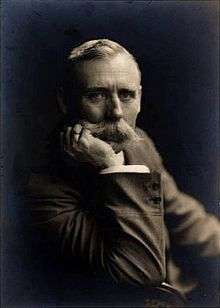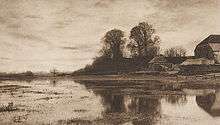James Booker Blakemore Wellington

James Booker Blakemore Wellington aka J. B. B. Wellington (1858 Lansdown - 1939 Elstree) was an English photographer who originally trained as an architectural draughtsman. In the 1880s, however, an association with George Eastman in New York, drew him into the world of photography. Wellington was regarded as a pictorial photographer of note, while his work was clearly inspired by the paintings of John Constable and Thomas Gainsborough. He was invited to be a member of the Linked Ring Brotherhood in 1892, and was a regular judge on the selection and hanging committee of exhibitions held by the Photographic Society of Great Britain.[1] He was a frequent exhibitor at the Royal Photographic Society.[2]
Back in England he became a manager of Kodak's factory in Wealdstone and was responsible for a number of practical formulas for improving emulsions and developers, one being a negative intensifier containing silver nitrate, ammonium thiocyanate and sodium thiosulphate, and another being dry-collodion plates with improved sensitivity.[3] Around 1895 he and his brother-in-law H. H. Ward set up a photographic paper manufacturing company, Wellington & Ward. The firm later extended into plates and film manufacture. In July 1922 the company acquired Leto Photo Materials (1905) Ltd, and in 1929 was taken over by Ilford Ltd.. Before this Wellington had worked for Elliott & Fry of Barnet.[4][5][6] [7]


A collection of medals and photographs belonging to a descendent of Wellington was featured on BBC1's Antiques Roadshow programme on 20 February 2011.[8]
| Wikimedia Commons has media related to James Booker Blakemore Wellington. |
References
- ↑ Wellington & Ward at early photography.co.uk
- ↑ Exhibitions of the Royal Photographic Society 1870-1915
- ↑ British Journal of Photography Almanac Annual Summary of Photographic Inventions and Events in Photographic History/1892 at notesonphotographs.org
- ↑ J.B.B.Wellington at luminous-lint.com
- ↑ WELLINGTON, J.B.B., at photogravure.com
- ↑ Encyclopedia of nineteenth-century photography - John Hannavy
- ↑ "Amateur Photographers" in New York Times published July 6th 1890
- ↑ J B B Wellington archive revealed on BBC's Antique Roadshow at britishphotohistory.ning.com